Sustainable Procurement 101
Sustainable procurement positively impacts the planet, profit, and people. Learn how to make a sustainable procurement policy!
Looking for a comprehensive action plan to get started?
DOWNLOAD FREE PLAYBOOK
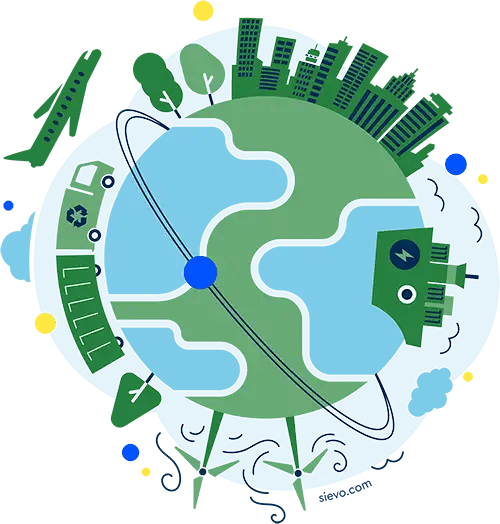
Updated: Nov 26, 2025
Key Takeaways
- Sustainable procurement means embedding environmental, social, and governance (ESG) criteria into purchasing decisions.
- ESG-focused procurement reduces supply chain risks, supports ethical suppliers, and improves regulatory compliance.
- Businesses can implement sustainable procurement through spend analysis, supplier engagement, and adopting international standards.
Sustainable business is also good business. It enhances supply chain resilience, sparks innovation, and positively impacts the triple bottom line: profit, people, and the planet.
Sustainable procurement is crucial for our duty to the planet and people. Thousands of companies are actively reducing their Scope 3 emissions and adhering to international standards for corporate responsibility. This shift towards sustainable procurement practices is not just about compliance but about seizing decarbonization opportunities and leveraging spend data for emissions reductions.
The world's largest companies are intensifying their sustainability efforts (BDO). In 2023, 99% of S&P 500 companies published sustainability reports, reflecting a near-universal commitment to ESG reporting. These companies view their suppliers as integral parts of their business ecosystem, collaborating with them to build capacity and mitigate long-term risks through sustainable sourcing strategies and procurement carbon reduction plans.
This guide will help you go from Net Zero to Carbon Hero! We will teach you the basics of sustainable procurement, best practices, and how to make a sustainable procurement policy. Additionally, you will learn how to measure and report sustainable performance based on KPIs.
Be sure to download the FREE PLAYBOOK to start building your sustainable procurement policy.
What is sustainable procurement?
Sustainable procurement is the strategic integration of environmental, social, and governance (ESG) criteria into all organizational purchasing and sourcing decisions.
This approach evaluates suppliers and products based on their environmental impact, social responsibility practices, and governance standards alongside traditional factors like cost, quality, and delivery performance.
Key Definition Components
Environmental Criteria: Carbon footprint assessment, waste reduction, renewable energy usage, circular economy practices, and environmental compliance tracking.
Social Criteria: Labor rights protection, diversity and inclusion programs, fair wage policies, health and safety standards, and community impact assessment.
Governance Criteria: Ethical business practices, anti-corruption policies, regulatory compliance, transparency standards, and supply chain traceability.
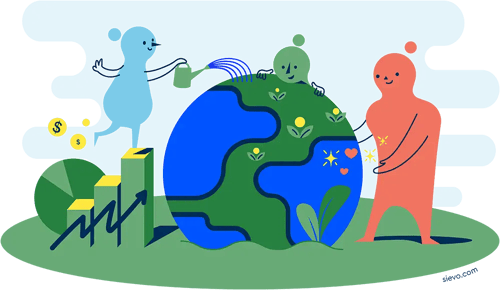
The benefits of sustainable procurement
Sustainability is a business imperative. To keep up with the market, create customer value, and innovate with suppliers, leading companies are setting ambitious ESG goals.
A cohesive ESG strategy can affect the bottom-line profits. McKinsey’s research shows that strong ESG credentials drive down costs by 5-10%, and top ESG performers have higher growth and valuation by margins of 10-20%.
Sustainability also drives resiliency, as sustainable practices increase transparency and a holistic approach to Procurement. Robust analytics and visibility into the supply chain can identify potential shortages and supply shocks. A governance policy can also reduce risk through fraud and corruption. You have more visibility into potential threats, especially ones related to the environment and society. This risk mitigation covers short-term and long-term planning for business contingency.
Finally, ESG policies carry substantial brand value. Companies that focus on social impact like work-life balance can be more attractive employers. The environmental impact of companies is a significant factor in what employers people choose. 69% of workers note the company’s environmental record as a factor for a job.
Here are even more benefits summarized in the table below:
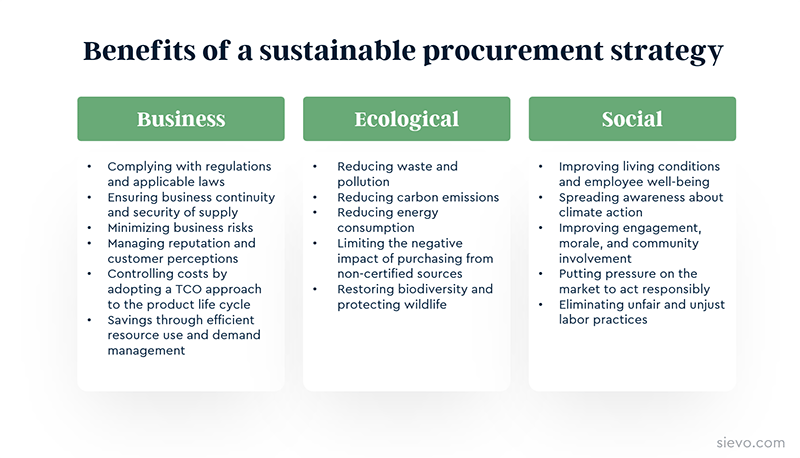
Models for Sustainable Procurement
Let's begin with a little bit of theory and terminology. The triple bottom line, ESG, and Scope 1, 2, & 3 emissions are important concepts to grasp before diving in.
The Triple Bottom Line in procurement
The triple bottom line (TBL)—or the 3P’s (profit, people, and the planet)—is a business idea that companies should consider more than just their financial performance. Companies should assess the social and environmental impact of the company as well.
Assessment of the company’s footprint in society is no longer optional. When organizations embrace sustainability, they believe in creating value for all stakeholders. These include customers, suppliers, employees, and the broader community. The challenge for Procurement is integrating these considerations into the decision-making process.
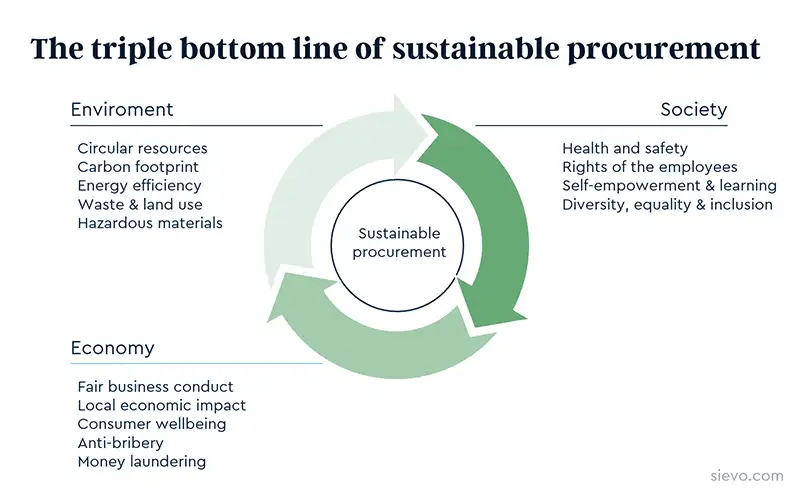
Environmental, Social, and Governance (ESG) framework
ESG is another way of breaking down the parts of sustainable procurement.
Environmental criteria apply to things like CO2 emissions and waste; social factors include diversity, well-being, and more; governance relates to the laws and certification compliance. All three parts are equally important.
The ESG framework applies to each stage of the supply chain, from sourcing to delivery. Leading global organizations recognize that sustainable supply chains can offer competitive advantages. So, organizations must also put pressure on their suppliers to embrace sustainability.
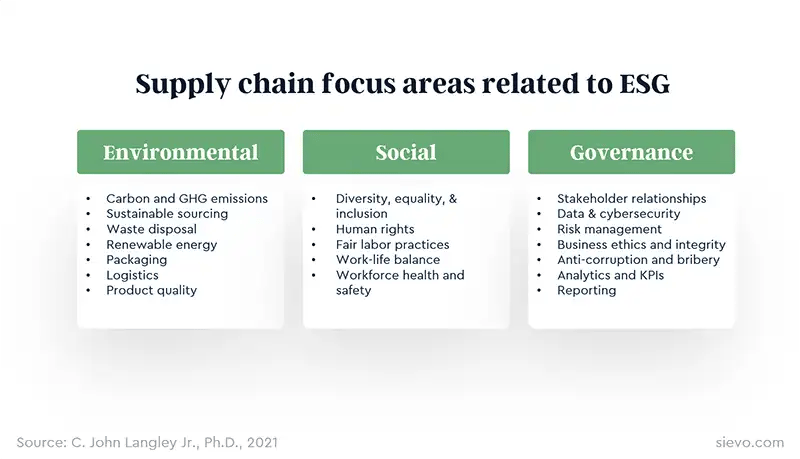
GHG footprint: Scope 1, scope 2, and scope 3 emissions
The Greenhouse gas (GHG) protocol is the world’s most widely used greenhouse gas accounting standard. Since 2001, governments, NGOs, and corporations have used their principles in accounting for GHG emissions. They state that GHG emissions fall into 3 “scopes.”
Scope 1 Emissions (Direct): Emissions from company-owned facilities, vehicles, and operations directly controlled by the organization.
Scope 2 Emissions (Indirect Energy): Emissions from purchased electricity, heating, cooling, and steam consumed by the organization.
Scope 3 Emissions (Supply Chain): Emissions from suppliers, business travel, employee commuting, product use, and end-of-life disposal—representing up to 70% of total organizational emissions.
Here’s an example of the emissions from a car’s production:
-
Upstream Scope 3 emissions come from suppliers’ sourcing processes, facilities, and transport. It also includes other indirect emissions, like employee commuting.
-
Scope 2 emissions come directly from the purchased water, heating, and electricity providers.
-
Scope 1 emissions come from the car’s manufacturing and transport. These are the “direct” emissions from the manufacturer.
-
Downstream Scope 3 emissions come from non-company owned transport, business travel, use of the vehicle, end-of-life processing, etc.
What is and isn’t scope 3 is hard to discern. However, reducing (or compensating) scope 3 emissions is essential to combating climate change. It is also the area where Procurement has the best chance to influence GHG reduction initiatives. Carbon ACTION Starts with unlocking the power of your spend data to drive meaningful carbon reduction initiatives.
Here's a video explaining how to reduce Scope 3 emissions:
Examples of Sustainable Procurement
Sustainable procurement is implemented from the beginning of identifying a purchase need and involves the whole supply chain.
In the past, green procurement only focused on the environmental aspects. However, today organizations are beginning to take a more holistic approach that considers social and economic factors.
Here are examples of sustainable procurement in practice from the private and public sector:
Sustainable sourcing
Sustainable procurement can be seen in new sourcing strategies. In 2022, 24% of manufacturing executives considered moving operations closer to the end customer.
Onshoring, or local sourcing, improves your agility to counter supply-chain disruptions. By bringing the supply chain closer, you also are reducing carbon emissions and saving on costs.
Another example is sourcing recycled or upcycled material alternatives. Such material innovations have raised investment from leading fashion brands and retailers.
-
Infinited Fiber, a company that recycles trashed textiles into premium-quality fibers, raised 30 Million euros in investment from brands like Adidas, BESTSELLER, and H&M.
-
Spinnova is another textile solution made of wood or waste, saving more CO2 emissions than it emits. They had an impressive 135 Million IPO, and Adidas has unveiled the first Adidas product made with SPINNOVA® fibers.
-
Finnair renewed its onboard amenities package with less SUP (single-use plastic) and more sustainable material sources. The toothbrush is made of bio-plastic containing cornstarch instead of plastic. Plastic wrappings for the earplugs are now wax paper. The Business Class slippers are made entirely from recycled PET plastic bottles. With these changes, Finnair has reduced plastic waste by almost 4,500 kilograms per year.
Sustainability as a competitive strategy
More companies are entering the market with sustainable product offerings and company missions. These companies align their core values with sustainably minded customer segments to differentiate.
Sustainability can drive innovative product design. Here are a few examples of companies strengthening the circular economy with sustainable innovations:
-
Repreve – a company turning plastic from the oceans into recycled fibers. Their material is used in Ford car seats and The North Face products.
-
Sulapac – a company that has created an eco-friendly alternative to plastic that can be created using existing plastic product machinery. Their material is featured in N° 1 de CHANEL and Four Seasons Resort.
-
Huhtamaki – a sustainable food and packaging solution, tackling high waste to-go packagings like coffee cups and lids. Huhtamaki Future SmartTM paper cup is the first 100% renewable paper cup made from plants.
Sustainability requires understanding the business landscape to maintain profitability and achieve competitive advantage. Without intelligent business thinking, you can’t do good! That’s why sustainability also takes business smarts.
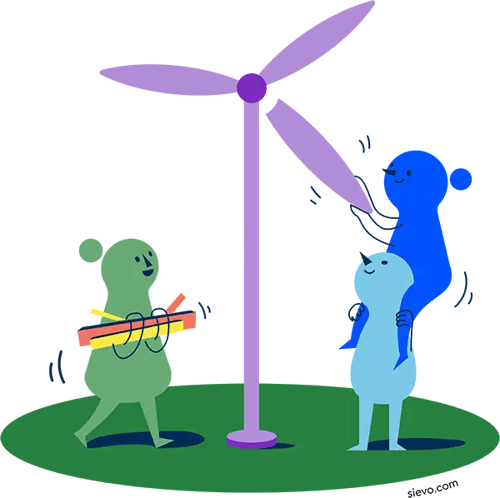
Sustainable public procurement
Public procurement organizations also have a chance to make an impact. Sustainable public procurement (or Green Public Procurement) applies to government departments and local bodies.
Alongside the private sector, the public sector can also apply the principles in this guide. Because public procurement involves spending taxpayer money, it’s even more critical to consider stakeholders’ interests and values. It’s not always easy to satisfy many stakeholders when politics are involved.
Many local and national governments are forming strict guidelines on the ESG factors of public spending. Sustainable public procurement policies address sustainability through governmental spending. It tackles the sustainable agenda through buying solutions, vendor selection, and life cycle assessment.
Additional reading on sustainable public procurement:
-
UN Environment Programme Sustainable Public Procurement Article
-
History of European Commission’s Green Public Procurement Initiatives
Drivers of sustainable procurement
There are both external and internal drivers affecting ESG practices in Procurement. Some relate to global macro trends, while others are company-specific. The three biggest drivers for sustainable procurement are Legislation & regulation, Industry competition & stakeholder pressure, and CSR & making real change.
These drivers are enough to start addressing sustainability in procurement. Eight capabilities are required for a sustainable procurement strategy:
-
Understanding of global, regional, and local actions
-
Support from mission, culture, strategy, and people
-
CSR committed leadership
-
Integration of strategic and operational decision making
-
Performance measurement and appropriate reward systems
-
Systematic risk management approach
-
Transparent and well-structured communication
-
Seeing sustainability as an opportunity for innovation
These requirements summarize a high-level commitment from management, a strategic vision tied to the company culture, and policies that affect the decision-making level. Most importantly, sustainability must be a strategic initiative—not just a reporting requirement.
The importance of data and analytics
Good data is needed to increase supply chain transparency and understand performance. One way to address this is to improve your primary data availability and quality, e.g., by collecting data from your key suppliers.
Also, you should capture high-quality secondary data, like average emissions by industry and manufacturing locations. This data guides strategic actions, like focusing on emission hotspots in the supply chain.
You need good data and analytics to identify sourcing opportunities, consolidate suppliers, and make decisions that can help meet your sustainable sourcing goals. Assessing supplier performance and total cost of ownership (TCO) is necessary for effective sourcing decisions.
Seasoned procurement professionals know that TCO is much more than the price tag. The same applies to sustainable performance evaluation.
A supplier may use renewable materials, but the total carbon footprint may rise due to the long transportation distance.
External data partners
Procurement analytics benefits from enrichment from third parties. Having external data integrated into your internal systems gives you a more enhanced view of your company's sustainable performance.
That’s why Sievo works with leading data providers to enrich your spend data and monitor sustainability:
-
Dun & Bradstreet Corporation: provides commercial data, analytics, and insights on over 100 million businesses around the world. Through a global partnership with Bisnode, Dun & Bradstreet’s data is automatically integrated into Sievo’s procurement analytics platform and updated in real-time, providing customers with immediate access to more accurate information on their supplier relationships.
-
Ecoinvent: publishers of the world’s most consistent and transparent life cycle inventory database.
-
Ecovadis: the world’s most trusted provider of business sustainability ratings, intelligence, and collaborative performance improvement tools for global supply chains.
-
Exiobase: a global, detailed Multi-Regional Environmentally Extended Supply-Use Table (MR-SUT) and Input-Output Table (MR-IOT).
-
Rapidratings: sophisticated analysis of the financial health of public and private companies in over 150 countries worldwide. The company’s predictive analytics provide insights into how suppliers, vendors, and other third parties are likely to perform.
-
Riskmethods: helps you proactively identify, assess and mitigate various supply chain risk.
-
Supplier.io: the global leader in supplier diversity solutions for over 20 years, serving over 30% of fortune 500 companies.
How to create a sustainable procurement policy
A sustainable procurement policy is a document that outlines the goals, processes, and KPIs of a sustainable procurement strategy. It should clearly state your ESG goals and processes to achieve them.
In 5 steps, you’ll learn how to create a sustainable procurement policy.
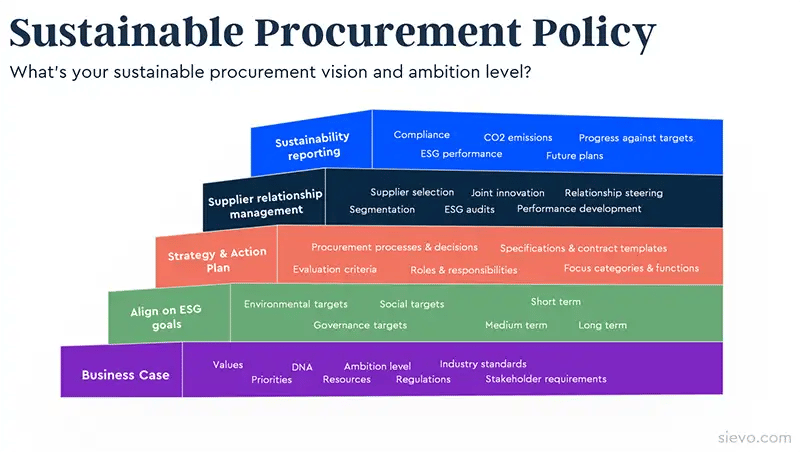
1. Building the business case for sustainable procurement
Building a viable case for sustainability includes factors such as your organization’s needs, priorities, values, resources, and stakeholder requirements.
Identify focus areas and priorities. These are some valuable considerations for understanding your sustainable business case:
-
Is sustainability a core company value and part of your DNA?
-
Are you incorporating sustainable practices to please your target market or to satisfy your investors and stakeholders?
-
Are you driving sustainable procurement initiatives to comply with government regulations?
-
What is the role of procurement in your organization?
Once you have the purpose figured out, engage in discussion with other stakeholders:
-
Align the internal stance on sustainability.
-
Identify which country-specific standards and regulations affect you and which functions in your business would be responsible.
-
Consider what level of depth your key stakeholders expect of you.
-
Consider the industry standard for sustainable development and the potential for competitive advantage.
Discuss your sustainable procurement vision and ambition level. Be inspiring yet realistic. Supplier scoring is one way to set realistic and efficient targets.
Ensure the Management, Procurement, Sustainability, and Compliance teams agree on the business case and benefits. Ensure top management engagement to develop and implement a sustainable procurement policy. Assign business sponsor and owner for the policy.
When your purpose and direction are clear, you can begin the next steps of the sustainable procurement policy.
2. Align on ESG Goals
Different business models and industries may have other focus areas of their CSR policies. The business priorities and risk areas most relevant to you should guide your sustainable procurement strategy. Setting ESG targets provides direction, commitment, and a way to measure progress.
Examples of ESG goals for sustainable procurement policy:
Environmental targets:
-
100% compliance with environmental guidelines in your industry
-
100% of key suppliers’ environmental impact assessed
-
X% reduction in consumption of resources such as energy and water
-
Become carbon neutral by 2030
-
Plastic free by 2030
Social targets:
-
Commitment to United Nation’s Sustainable Development Goals
-
100% compliance with paying living wages and eliminating child labor
-
100% compliance with health and safety audit standards
-
100% compliance with the Modern Slavery Act
-
100% compliance with The United Nations Guiding Principles on Business and Human Rights (UNGPs)
Governance targets:
-
100% compliance with regulations and applicable laws
-
100% compliance with terms for anti-bribery and anti-money laundering
-
X% of key suppliers engaged in joint sustainability program
-
X% of suppliers are diverse suppliers
Once your ESG goals are established, conduct a current state analysis. Current state analysis is built on data. Identify gaps in your current practices, processes, and sustainable performance. Assess the current state against your ESG goals and future legislative requirements. You might identify new focus areas.
Remember to update your targets with your industry by joining initiatives like Together for Sustainability (chemicals), Railsponsible (rail), or AIAG (automotive). Joining an industry initiative and matching targets is a great way to stay accountable.
3. Build strategy and action plan
Your sustainable procurement policy should be clear and understandable so that everyone making purchase decisions in your organization knows their responsibilities.
Translate your ESG goals into your procurement processes and decisions. Redesign your purchase-to-pay process and map decision points for making more sustainable choices. Additionally, you should include sustainability in your RFP evaluation criteria.
Making sustainable decisions is not always easy. Help your procurement team make future-proof decisions with data, tools, templates, and decision trees.
Category management: Identify your most significant procurement categories with the highest sustainability impact and risks. Then, develop a sustainable procurement strategy and action plan for each category.
Communicate internally: Communicate your sustainable procurement targets internally and engage with stakeholders, e.g., through Q&A sessions. See the implementation process through the function and category level. Promote responsible purchase behavior.
Roles and responsibilities: Introduce the responsibility assignment matrix (RAM), also known as RACI matrix. RACI stands for responsible, accountable, consulted, and informed. Here’s an example from the Cacao category,
Responsible = Director Direct Spend
Accountable = Cacao Category Manager
Consulted = Raw Material Sustainability Manager
Informed = Chief Procurement Officer
Aligning roles and responsibilities will enable the effective execution of your plan and helps avoid misunderstandings later on.
Knowledge sharing: Sustainability is a challenge and opportunity for all procurement organizations. They are in different stages of maturity and have different focus areas depending on their industry field. Benchmark and share best practices with your industry peers and other procurement professionals that be further on in the process. Sharing success stories can be insightful and motivating.
4. Supplier management and performance development
The importance of suppliers to sustainable procurement can’t be understated. You should develop a consistent approach to supplier selection and share your sustainability criteria with your suppliers in the sourcing and onboarding phase. Communicate your sustainable procurement policy, mission, and targets to your suppliers.
Identify strategic and critical suppliers whose actions make the most significant impact on sustainability. Use supplier segmentation practice that is supported by your procurement team. Your policy may include different levels of sustainable practices and verification methods depending on the product’s or service’s purchase volume and business impact.
Here's a useful 4-layer Responsible Sourcing Framework you can use to assess suppliers. 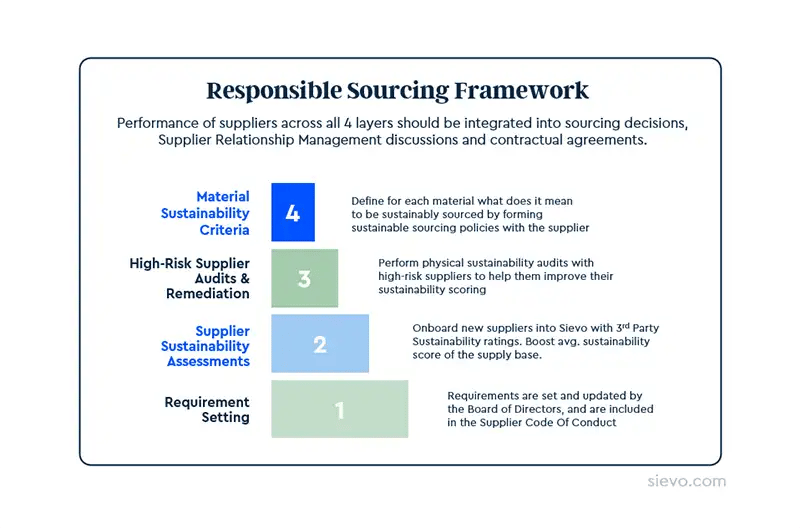
Be transparent about their performance—onboard your suppliers to relevant programs and follow up on their progress with sustainability KPIs. Consider implementing environmental and sustainability audit standards, develop performance together, and validate corrective actions as needed.
Your sustainable procurement policy should clearly state how to monitor and report supplier performance. The policy should also outline the implications of sub-optimal performance, breaches, and audit deviations.
5. Sustainability reporting
Sustainability reporting is a part of an organization's annual reporting process. There is a growing demand for more accurate reporting on sustainability programs. Sustainability reporting depends on demonstrating success through data and reliable information.
Reports have two objectives: to monitor compliance and inform future targets and sustainability plans.
Procurement teams are employing new data and analytics approaches to look at the sustainability of their products and services. With available sustainability data and analytical tools, it is possible to establish ESG performance development programs and track carbon footprint on the category, business unit, line, supplier, and product level.
Monitoring the sustainable performance of suppliers entails continual assessments and measurements. This monitoring is essential for your strategic Tier 1 suppliers.
Data sharing and analysis are vital to sustainability tracking and reporting. Luckily, the market availability and competence to gather reliable sustainability data have gone through the roof. There are solutions to establish baselines, assist in setting KPIs, track progress, and report successes.
Also, professionals can share plans and metrics with their partners and stakeholders through dashboards and portals that are secure, timely, and private. These analyses require reliable data sources (internal and external), automated data management, and skilled expertise in combining those for meaningful insights.
KPIs for sustainable procurement
Each organization will choose different metrics based on what is important or material to their business and industry. Environmental metrics cover various activities impacting climate, waste, and energy use. Social and governance metrics can be more region and company-specific but have good examples to follow from leading sustainable organizations.
Carbon emission KPIs
Greenhouse gas (GHG) emissions and other pollutants are the major factors contributing to climate change. The UK-based Carbon Disclosure Project (CDP) helps disclose major corporations' environmental impact. Also, the International Integrated Reporting Council (IIRC) provides a comprehensive corporate reporting option useful when proving sustainable value to potential investors.
Organizations can assess how their products or services contribute to climate change.
-
CO2 emissions (direct)
-
CO2 emissions (indirect)
-
CO2 emissions from business travel per employee
-
Other toxic emissions by type
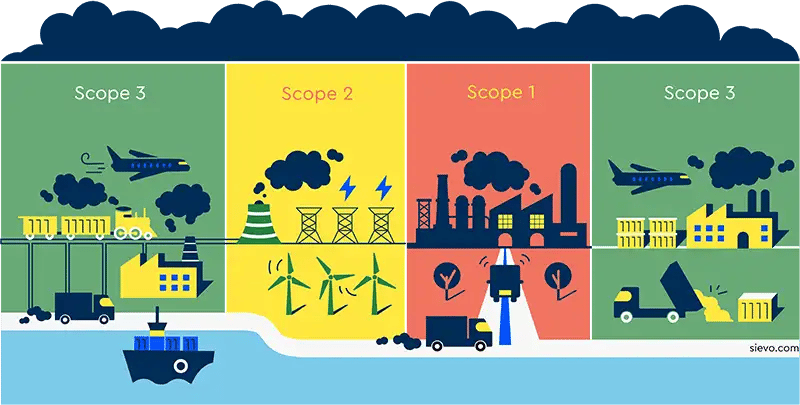
Power and energy KPIs
Water is also a key sustainability metric for many organizations, especially in manufacturing and FMCG. Organizations can track their water usage, quality, the cost of water pollution on the environment, and loss of water through leaks and evaporation.
Companies are also beginning to focus on contributing to the circular economy through waste management. Waste includes food and packaging waste, hazardous materials, debris, industrial waste, and final disposal. You can replace plastic packaging and single-use materials with recycled, recyclable, routable, or circular materials.
These measures look at energy operations and identify where to use less, resulting in cost savings and fewer emissions.
-
Energy consumption used in production kWh / month
-
Energy use in offices, kWh / m2 / month
-
Energy saved due to implemented improvements, %
-
Fuel consumed in the transportation of goods
-
Total supply chain miles
-
Water usage
-
Water consumption in liters
-
% of water recycled
-
% of water reused
-
Product waste by type, volume, and disposal method
-
% of recycled materials used
-
Returned/reused/recycled packaging
Social KPIs
Measuring performance against human rights goals such as improvement in living conditions and creating work opportunities in affected communities requires data and detailed analysis. Some easily quantifiable metrics include employee welfare, diversity, and inclusion. Tracking other social metrics is less straightforward.
Download our Whitepaper on Supplier Diversity in Procurement
The Anker Living Wage and Living Income Research Institute provides a methodology for producing high-quality, consistent, objective information about living wages and wage gaps. The aim is to support wage improvement strategies and programs in ESG projects.
These KPIs track social impact. They should include measures of the quality of life for employees and the wider community. Suggested KPIs are:
-
Employee engagement and satisfaction
-
Community engagement, volunteering hours
-
Near miss incidents reported
-
Number and type of unsafe behaviors reported
-
Success of sustainability awareness training
-
Work-life balance, working hours
-
People development, learning hours
-
Number of community-based initiatives
-
Diversity, equity, and inclusion (DEI) survey result
-
% increase in diverse suppliers

Governance KPIs
Finally, for governance-related metrics, KPIs should reflect your level of adherence to regulations within your specific industry sector. They should consider the compliance of both your organization and your supplier base. Corporate governance KPIs include:
-
% supplier compliance to code of conduct/guiding principles
-
Compliance with industry regulations
-
Compliance with UN global conduct
-
Compliance with safety and security requirements
-
% of suppliers audited against CSR standards
-
Share of suppliers that filled in the self-assessment questionnaire (SAQ)
Demystifying carbon reporting frameworks
In an era of heightened environmental consciousness, businesses are increasingly turning to carbon reporting frameworks to measure, manage, and mitigate their carbon footprint. These frameworks provide structured approaches to assessing and disclosing greenhouse gas emissions, enabling companies to enhance transparency, accountability, and sustainability performance.
Carbon Disclosure Project (CDP)
The CDP is a globally recognized platform that collects environmental data from thousands of companies worldwide, including information on supply chain emissions. By participating in CDP's annual questionnaire, companies can disclose their emissions data, risks, and opportunities associated with their supply chains.
The CDP provides a valuable benchmarking tool for companies to compare their performance against industry peers and identify areas for improvement in supply chain sustainability.
Greenhouse Gas Protocol (GHG Protocol)
The GHG Protocol, developed by the World Resources Institute (WRI) and the World Business Council for Sustainable Development (WBCSD), provides standards and guidelines for measuring and reporting greenhouse gas emissions.
The GHG Protocol's Corporate Value Chain (Scope 3) Accounting and Reporting Standard offers a comprehensive framework for companies to assess and report their Scope 3 emissions, including those from their supply chains. By following GHG Protocol methodologies, companies can ensure consistency and comparability in emissions reporting, facilitating informed decision-making and targeted emissions reduction strategies.
Task Force on Climate-related Financial Disclosures (TCFD)
The TCFD provides recommendations for disclosing climate-related risks and opportunities in financial filings. While not specific to supply chain emissions, TCFD encourages companies to report on the climate impacts of their operations, including emissions from their supply chains, and to assess climate-related risks and opportunities in their business strategies.
By integrating TCFD recommendations into sustainability reporting, companies can enhance transparency and resilience in the face of climate change risks, fostering investor confidence and stakeholder trust.
Global Reporting Initiative (GRI)
GRI provides sustainability reporting guidelines that include requirements for reporting greenhouse gas emissions. GRI encourages companies to report on their scope 3 emissions, including those from their supply chains, to provide stakeholders with a comprehensive view of their environmental impacts.
By aligning with GRI standards, companies can demonstrate their commitment to transparency and accountability in sustainability reporting, enhancing credibility and trust among stakeholders.
ISO 14064-1
ISO 14064-1 is an international standard that provides guidelines for quantifying and reporting greenhouse gas emissions and removals. While not specific to supply chain emissions, ISO 14064-1 can be used by companies to develop consistent and transparent reporting of their emissions, including those from their supply chains.
By adhering to ISO 14064-1 requirements, companies can enhance the reliability and credibility of their emissions data, facilitating informed decision-making and stakeholder engagement in sustainability efforts.
How to measure sustainable performance
The requirements for sustainable procurement are evolving. As such, the KPIs need to develop as well. Companies must evaluate supplier commitment and performance.
There are many factors to success in sustainability performance tracking: reliable data, industry knowledge, and analytical competence. Besides tracking KPIs, procurement must also be able to communicate performance and enable change in the organization.
Procurement needs to identify emission hotspots and which areas of spend have the highest ESG impact and potential for improvement. Focus your primary efforts on key suppliers and risk categories where you can make the most significant impact.
The best way to ensure the continued relevance of sustainability is through reporting. Using formal standards keeps your reporting structured and transparent.
Although sustainability reporting is a whole other topic, the more global companies standardize their reporting practices, the easier it will be to make comparisons.
So far, there is no globally accepted sustainability tracking and reporting system. However, the GRI Standards come close, used by 73% of the world's 250 largest companies. The GRI Standards are a modular system comprising three series of Standards: the GRI Universal Standards, the GRI Sector Standards, and the GRI Topic Standards.
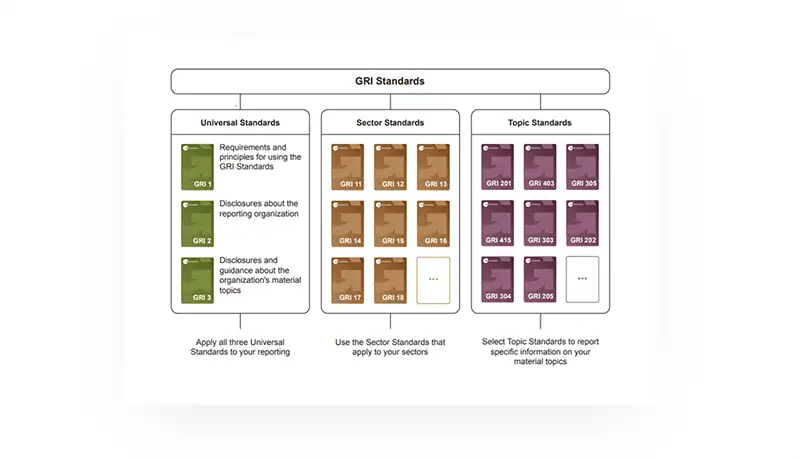
A carbon management tool gives you a place to track carbon and GHG emissions. By combining external data on suppliers and your spend data, you can identify the footprint of your activities.
Other functionalities of carbon management software are:
-
Capturing emissions data across scope 1, 2, and 3 sources
-
Ready-to-Act CO2 Insights: get AI-powered insights that pinpoint decarbonization opportunities, ready for immediate action.
-
Benchmarking against your KPIs and visualizing the results
-
Enhancing your sustainability reporting with more granularity
-
Targeting the most effective reduction strategies
-
Generating what-if scenarios and gaining insights
-
Budgeting your carbon footprint and preparing for Net-zero emissions
Sustainability in supplier selection and development
Suppliers play an essential role in your sustainability journey. They can only engage if they understand your goals and their role in achieving them. Suppliers will support you and can even drive new innovative solutions.
Supplier relationship management (SRM) is a business initiative aiming to increase supplier performance through collaboration and incentives. SRM is the perfect tool for communicating targets and improving sustainability performance.
Successful SRM aims to create value for both parties. SRM is not a one-time effort. It requires consistency and good intentions. Joint research and development with suppliers can help innovate new solutions.
Likewise, you should see what others are doing, collaborate with partners, share best practices with industry peers, and be part of the broader global discussion. As there is more demand and standardization in sustainability, the research, development, and implementation costs decrease too.
Selecting sustainable suppliers
Translating your organization’s sustainability goals into the supplier selection process is the first step. By doing this, you make sure you select suppliers that support your ESG goals.
Manufacturers like Nike and Adidas have suffered fallout because their suppliers dumped toxins into China’s rivers. This could have been avoided with the proper sustainability criteria.
Basic supplier selection criteria only consider price, delivery, and quality. A more nuanced approach considers the total cost of ownership (TCO), product quality, capabilities, consistency, and risk. More companies are considering sustainability as a supplier selection criterion.
Here are some example questions that you can use to start a sustainability conversation with suppliers:
Supplier’s Environmental Standards
-
Do you use a certified environmental management system (EMS)?
-
How do you manage emissions, energy, waste, and water use?
Supplier’s Social Standards
-
What is your policy on human rights/fair pay/working conditions/diversity?
-
Do you comply with UN Global Conduct?
-
Do you comply with fair trade practices?
-
What is your health and safety record?
Supplier’s Governance
-
Do you have an anti-bribery and anti-corruption policy?
-
Do you comply with industry regulations and legislation?
-
Have you ever been prosecuted or fined for infringements?
Your suppliers may ask "what's in it for them" to comply with the new practices and requirements. Staying in business together is an obvious benefit. An additional benefit is shared innovation, research, and development. These initiatives impact future success and customer satisfaction for both parties.
Sustainability is a joint effort and teamwork, however. Collaborative development in sustainability leads to new products, more intelligent solutions, and more efficient processes. The aim is to support and promote progress and improvement rather than impose penalties.
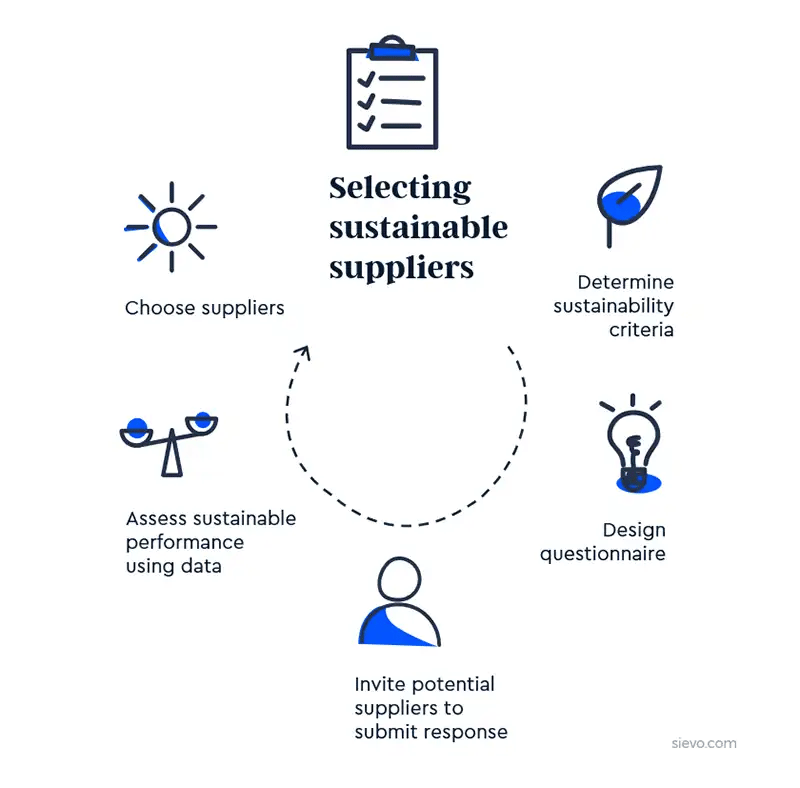
Supplier segmentation
Supplier segmentation enables an organization to manage its internal and external resources more efficiently. Supplier segmentation separates suppliers based on their business impact, criticality, and spending. Standard supplier segments include critical ("key suppliers"), volume, bottleneck, and routine.
Often, SRM efforts focus on strategic partners, key suppliers, or at-risk suppliers. Key suppliers have the highest amount of spend to have a positive influence in terms of sustainability targets. At-risk suppliers have the highest amount of potential risks.
There are many ways to identify suppliers' risk potential. You can use an ABC method, geographic analysis, third-party reporting, indexes, scorecards, and assessment protocols. Pareto analysis and spend analysis can show which suppliers are most at risk for supply disruptions.
Establishing governance models and relationship steering
An SRM governance model is the structured organization of people, controls, and mechanisms. In general, a governance model includes:
-
Processes and escalations for problem-solving.
-
Accountable people and their roles and responsibilities.
-
Descriptions of the corporate relationships, obligations, and levels of collaboration.
When making a governance model, top management agrees on the sustainable development targets, account management translates those targets into a roadmap and performance measures, and operations ensure the execution of the objectives in day-to-day business operations.
An SRM steering group allows for a structured approach to managing relationships, making decisions, and guiding the work. Steering groups consist of experts with experience and knowledge on specific topics. For example, the steering group of a key supplier relationship could include sustainability, human rights, or circular economy advisors.
Supplier development
Developing sustainability with suppliers requires continuous improvement. That means setting goals and tracking performance. Select key performance indicators (KPIs) relevant to your supplier’s and business performance. The service level agreement (SLA) specifies how and when KPIs are measured.
By working together, you and your suppliers can become more resource and energy-efficient, optimize your processes, reduce waste, and generate sustainable innovations.
In sustainable supplier management, developing together is the key. Your suppliers can provide a new perspective and fresh ideas for implementing responsibility into your supply chain, product development, and sourcing. As your organization grows in maturity, you can build innovative partnerships to embed best practices in all sourcing decisions and look beyond Tier 1 suppliers.
Consider organizing industry-specific development and knowledge-sharing days. Reward and acknowledge the best performers.

Joint Innovation
In the Harvard Business Review article "A new approach to contracts," the authors suggest that the remedy is to adopt a different kind of arrangement. A "relational contract" creates a flexible framework designed to foster collaboration. These legally enforceable contracts specify mutual goals and establish governance structures to align the parties' expectations and interests.
Contract forms a platform and structure for collaboration and sustainable development. A sustainable contract benefits both parties and evolves.
In true partnerships, each party is committed to the other's success through joint commitments and development initiatives. Traditional contracts rarely support these intentions. They only describe the parties' transaction and commercial responsibilities.
These purchase and supply agreements are often not designed to nurture mutually beneficial long-term relationships. Many use the word partnership loosely when in reality, the benefits are one-sided and favor the buyer.
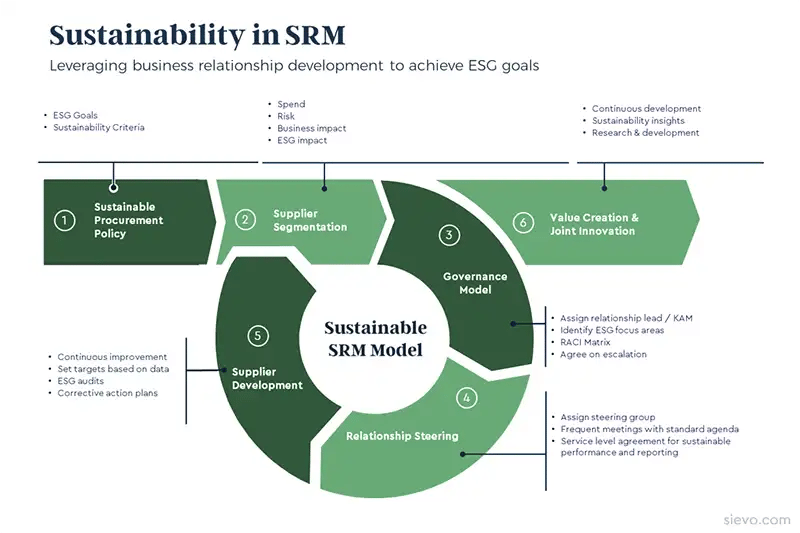
Sustainability in law: Legislation examples
The requirements for Procurement and Supply Chain are in constant development. As sustainability regulation becomes more complex, global companies could lose their license to operate and face significant brand damage if they aren’t compliant in the eyes of the stakeholders.
Sustainability is no longer a demand driven by NGOs and active consumers—it's a legislative requirement for companies. Working with a network of partners specialized in sustainable procurement helps keep up with these changes and updates.
Here are the most commonly known guidelines for measuring ESG performance:
Here are legislation examples driving sustainable procurement practices:
The European Green Deal (EGD) and the Corporate Sustainability Reporting Directive (CSRD) are both key components of the European Union's (EU) strategy to achieve sustainable development and combat climate change.
Corporate Sustainability Reporting Directive
The Corporate Sustainability Reporting Directive (CSRD) is a significant legislative initiative by the EU aimed at improving and standardizing corporate sustainability reporting. It builds upon the existing Non-Financial Reporting Directive (NFRD), expanding its scope and transparency of sustainability disclosures. Here’s a detailed overview of the CSRD:
The CSRD aims to ensure that companies provide comprehensive and reliable sustainability information to stakeholders, including investors, consumers, policymakers, and the public. From 2025 onward, companies will be required to report and disclose detailed information on their performance in specified areas:
-
Environmental matters
-
Social matters and treatment of employees
-
Respect for human rights
-
Anti-corruption and bribery
-
Diversity on company boards
Blog: Everything you need to know about the CSRD
EU Green Deal
The EU Green Deal aims for climate neutrality by 2050, introducing measures to cut greenhouse gas emissions. The framework outlines a wide range of actions and strategies designed to reduce greenhouse gas emissions, promote resource efficiency, and foster inclusive economic growth. Procurement and sustainability leaders should align their strategies with the EU Green Deal, incorporating sustainability criteria into procurement processes to achieve climate neutrality goals.
Circular Economy Action Plan
The Circular Economy Action Plan (CEAP) is a key component of the European Green Deal. It aims to promote sustainable growth by transitioning from a linear to a circular economy. The plan focuses on reducing waste, enhancing resource efficiency, and creating a closed-loop system where products, materials, and resources are maintained in the economy for as long as possible.
Procurement leaders should align sourcing with circular economy principles, prioritizing sustainable production and consumption. Sustainability leaders can champion circularity initiatives and collaborate with suppliers on circular business models.
Sustainable Finance Disclosure Regulation
The Sustainable Finance Disclosure Regulation (SFDR) requires European financial market participants to disclose environmental sustainability information, encouraging companies to address scope 3 emissions.
SFDR seeks to mitigate greenwashing, foster trust, and encourage sustainable investment practices. It plays a crucial role in aligning the financial industry with the EU's broader sustainability goals and the European Green Deal.
Carbon Border Adjustment Mechanism (CBAM)
Carbon Border Adjustment Mechanism (CBAM) is an initiative by EU designed to propose carbon tariffs on imported goods to prevent carbon leakage and incentivize emission reductions. CBAM is a key component of EU strategy to achieve its climate goals, ensuring that imports are subject to the same environmental standards as domestic products. CBAM aims to encourage sustainable practices internationally, while protecting EU industries from unfair competition.
Revised Renewable Energy Directive (RED II)
Revised Renewable Energy Directive (RED II) aims to boost renewable energy deployment and sustainability criteria, affecting emissions from bioenergy production. Procurement leaders should explore renewable energy sourcing and support suppliers in adopting renewable solutions, while sustainability leaders advocate for renewable energy strategies aligning with sustainability goals.
Single-Use Plastics Directive
The Single-Use Plastics Directive (SUP Directive) is an initiative by EU aiming to reduce marine litter and environmental impact by restricting certain single-use plastic products and promoting alternatives and recycling. Procurement leaders must understand its implications on sourcing practices and product selection, while sustainability leaders can drive company-wide initiatives for plastic reduction and circularity.
Modern slavery legislation
Modern slavery can be defined as the recruitment, movement, harboring, or receiving of humans of all ages through force, coercion, abuse of their vulnerable position, deception, or other means of exploitation for commercial or personal benefit (UK Government).
In the UK, the Modern Slavery Act came into force in 2015, Australia followed in 2018. UK requires companies with a turnover exceeding £36m (incl. subsidiaries) that supply goods and services in the UK to disclose annually what they are doing to eliminate slavery from their businesses and supply chains. The Australian legislation requires organizations based or operating in Australia, with a turnover exceeding AUD $100 million, to report annually.
The EU has issued guidance on “forced labor” risks in operations and supply chains. Guidance is not legally binding yet. Belgium is an early adopter of modern slavery legislation. In 2021 the Federal Parliament voted in favor of a due diligence bill to strengthen the obligations of companies to identify and prevent human rights violations and to mitigate ESG risks in their supply chains. It includes criminal sanctions and compensation for victims.
Blog: Fighting Modern Slavery in Procurement
The German Supply Chain act
The German Supply Chain Act refers to the Act on Corporate Due Diligence Obligations in Supply Chains, or in German Lieferkettensorgfaltspflichtengesetz (LkSG) (“the Act”).
The Act requires large companies to identify, prevent, and address human rights and related environmental violations within their operations and their direct suppliers’ operations. It is the first legislative step requiring German companies to take more strict actions on sustainability. The regulations will initially apply to around 600 German companies.
Blog: How to be compliant with the German Supply Chain Act
Sustainable Procurement Best Practices
Now that you understand how the elements of sustainable procurement connect, you're ready to begin shaping your roadmap. While ESG goals vary by industry, embracing best practices early helps your team achieve meaningful results faster. Keeping these principles in mind will ensure steady progress:
1. Prioritize Supply Chain Visibility
Since up to 75% of CO2 emissions originate in your supply chain, a key principle is to accurately map your spend and identify the suppliers or categories responsible for the highest emissions.
Using structured data, ideally enriched with emissions models, you can pinpoint high-impact categories and establish a clear baseline. This is the foundation for targeting the biggest opportunities to reduce your carbon footprint. Advanced tools that automate data extraction and classification can further improve accuracy and efficiency in building that baseline.
TDC NET applied this best practice to gain real-time visibility into supplier-level emissions. With a clear baseline and hotspot data, they focused efforts where it mattered most, reducing Scope 3 emissions by 44% in just three years.
2. Embed Sustainability into Every Procurement Decision
Sustainability should be embedded into every stage of the procurement process. Procurement teams can better align their activities with broader sustainability goals by incorporating carbon metrics into supplier evaluations and performance management.
Evaluate suppliers not just on cost and quality, but also on carbon impact throughout the RFx and scoring processes. Treat ESG performance metrics as equally important as traditional procurement KPIs to drive balanced, responsible decisions.
For example, Deutsche Telekom now considers carbon impact a core procurement criterion, treating CO2 like a new currency in supplier decisions. Read the case study to understand how they embedded this mindset across a global supplier base.
3. Collaborate with Suppliers for Shared Impact
Suppliers are responsible for the majority of Scope 3 emissions. Move beyond compliance by collaborating on shared goals. This includes setting targets, exchanging data, and aligning on improvement roadmaps.
Understanding your suppliers’ emissions reduction commitments, such as Science-Based Targets, supports progress tracking. Use an analytics solution that maps suppliers to ESG frameworks to improve transparency and build stronger partnerships.
Discover how Sievo helps you identify, compare, and act on supplier SBTi performance.
4. Empower Procurement with Real-Time Insights
Achieving sustainability at scale requires equipping your procurement teams with knowledge and accessible insights. It’s not just about training, it’s about surfacing the right data at the right moment.
AI-powered features, like personalized insights, can simplify access to emissions data, eliminating the need for manual analysis or specialist support. By combining knowledge with accessible technology, organizations can make it easier for procurement teams to contribute meaningfully to sustainability goals.
5. Automate for Scalable Impact
As regulations evolve, manual emissions tracking simply doesn’t scale. Automation is key to staying compliant and efficient. Invest in tools that automatically collect data, perform GHG Protocol-compliant calculations, and minimize human error.
Sievo stands out by delivering audit-ready outputs and surfacing Scope 3 reduction opportunities with the highest climate impact. With automation and insight combined and all built into a single solution, you can move from just tracking to truly reducing emissions at scale.
Balance Cost and Carbon
Sustainability shouldn’t mean sacrificing savings. Sievo helps hundreds of customers focus their efforts and target-setting to areas of spend where it matters most. With CO2 Analytics, you get visibility into your Scope 3 emissions against your spend and discover ways to reduce them as efficiently and effectively as possible. Sievo CO2 Analytics is validated as a Top Solution by SpendMatters.
Don’t React, Just Act
Find opportunities to continuously improve your Environmental, Labor & Human Rights, Ethics, and Sustainable Procurement targets from your supply chain with Sustainability Analytics. Increase your supply chain’s agility and resilience through Sievo Diversity Analytics and gain a competitive advantage by expanding diversity in your supplier base.
From Data to Ready Reports
CBAM reporting is a regulatory requirement, but it doesn’t have to drain your team’s time and energy. Sievo CBAM Reporting reduces reporting work by 50%. Automate the entire process, from identifying CBAM-liable suppliers to generating submission-ready reports. Everything you need, from data collection to compliance tracking, is centralized in one clear, easy-to-use tool.
Benchmark your scope 3 emissions performance
Curious about how your supplier-related emissions measure up? In partnership with Deloitte, we have developed the Scope 3 Benchmarking tool to provide a clear view of your performance against industry peers.
FAQ
What’s the difference between green and sustainable procurement?
Green procurement focuses on environmental metrics only. Sustainable procurement includes environmental, social, and economic (ESG) criteria.
Is sustainable procurement practical for small and medium enterprises (SMEs)?
Yes. SMEs can incorporate ready-made ESG standards, join collective buying groups, or use digital supplier assessment tools to implement sustainable procurement.
How is ESG progress tracked in procurement?
By monitoring metrics such as carbon per spend, percentage of audited suppliers, diversity representation, and supplier compliance rates.
Which regulations impact procurement sustainability most?
EU Corporate Sustainability Reporting Directive (CSRD); Corporate Sustainability Due Diligence Directive (CSDDD); EU Deforestation Regulation (EUDR).
How does Sievo support sustainable procurement?
Sievo’s analytics platform integrates ESG data, spend analytics, and supplier performance management to help organizations track, benchmark, and improve sustainable procurement outcomes.
Want to improve your supplier performance and address the sustainability targets for your supply chain?
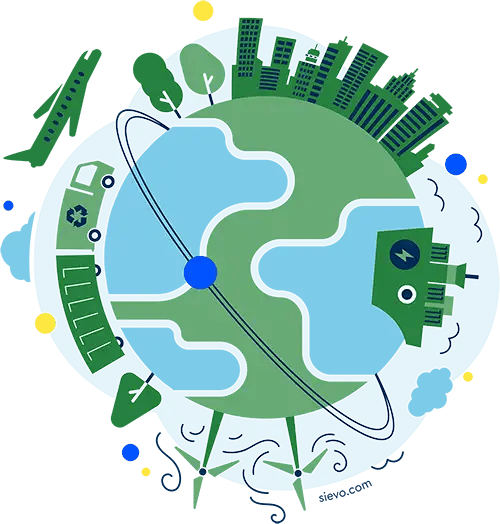
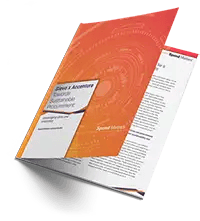
Strategically approach sustainability in procurement
This guide by Sievo and Accenture provides detailed and strategic steps to implement sustainability in your procurement function.

“We have a duty of care towards patients, our people and the environment and are committed to making our overall supply chain more energy efficient and environmentally sustainable. Having our GHG emission data accessible with high granularity levels at our fingertips is a key differentiator and will accelerate our objective to reduce our impact on the environment.”
Francois Rousselot – Group Head of Procurement at Hikma

